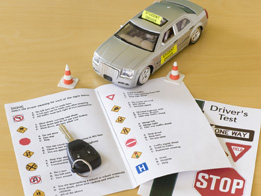Lesson 1
| Site: | MoodleHUB.ca 🍁 |
| Course: | Math 20-2 SS |
| Book: | Lesson 1 |
| Printed by: | Guest user |
| Date: | Tuesday, 30 December 2025, 1:35 AM |
Description
Created by IMSreader
1. Lesson 1
Module 4: Statistical Reasoning
Lesson 1: Organizing and Summarizing Data
Focus

Jupiterimages/Comstock/Thinkstock
Throughout your life, you have taken a number of tests or handed in assignments on a wide variety of topics. For instance, you might have taken a test to get your driver’s licence, to prove your knowledge of a subject in a class at school, or to become a certified scuba diver. Your marks on these tests may have been compared against your previous marks or against marks of other students. Not only are these comparisons used to evaluate the success of individual students and classes, but they can also be used to evaluate whether the test or specific assignment was a good measure of student success.
In this lesson you will investigate different tools that can be used to organize and summarize data so that data can be interpreted or compared.
This lesson will help you answer the following critical question:
- How can data be organized and summarized so the results can be compared?
Time
Each module is made up of lessons. Each lesson in Mathematics 20-2 is designed to be completed in approximately 80 minutes. You may find that you require more or less time to complete different lessons depending on your strengths. It is important that you progress at your own pace based on your individual learning requirements.
Assessment
All assessment items you encounter need to be placed in your course folder.
There are no marked assessment items for Lesson 1. While you will not be handing in any work from Lesson 1 for marking, the activities in this lesson will prepare you for other assignments in this module.
For those items that you will not be handing in for marking, you should have already had a discussion with your teacher about how you can access the solutions to these questions. Make sure to follow your teacher’s instructions.
This lesson provides you with opportunities to investigate, discuss, and practise the knowledge and skills you are learning. For instance, in a Share activity, you can check your answers with other students to see if you are on track. If you are having difficulty with concepts or calculations, contact your teacher.
Materials and Equipment
- graphing technology
- ruler
- 1-cm Grid Paper or 2-cm Grid Paper
1.1. Launch
Module 4: Statistical Reasoning
Launch
Are You Ready?
- Calculate the mean, median, mode, and range of the following set of data: 35, 23, 16, 24. Answer
- Use the gizmo “Mean, Median and Mode” to find the mean, median, and mode of a bunch of frogs. Answer
- Create a sentence that makes mathematical sense and that uses the number 6 and the words median, mean, and less. Answer
- The following numbers (in any order) represent the mean, median, mode, and range for a set of data:
12, 13, 14, 7
Which number makes the most sense for the range? Why? Answer
Refresher
For a review of how the mean, median, mode, and range can be used to represent data, type the words “NutShell Math Mean, Median, and Mode” into your favourite Internet search engine.
For further review, you may want to look at Mathematics Glossary for definitions of the terms mean, median, mode, and range. Click on Grades 7–9 and then choose the letter M. You can then find measures of central tendency, mean, median, and mode. Select the letter R to find out about range.
1.2. Discover
Module 4: Statistical Reasoning
Discover
There are a variety of tools and many different strategies for organizing and summarizing data. For instance, one student may perform calculations to summarize the data. Another student may use a graph to help visualize and summarize data. A third student may incorporate both calculations and visualizations of the data.
Share 1
After a discussion with your teacher, you will decide how to connect with other students for Share activities. Follow your teacher’s instructions to complete this Share activity. Place a summary of your Share discussion in your course folder. For more information on Share discussions, refer to the Course Introduction.
Mr. Kong has two mathematics classes. One class is first thing in the morning (Block 1), and the second class is the last class of the day (Block 4). Yesterday, Mr. Kong gave the same statistics quiz to both classes. The marks for each class are shown.
Statistics Quiz (out of 10 marks) Block 1 Class |
||||
9 |
6 |
8 |
7 |
8 |
8.5 |
8.5 |
4 |
5 |
7 |
7.5 |
5 |
6 |
7.5 |
6 |
8 |
7 |
5 |
8 |
9 |
7 |
8 |
7.5 |
4 |
7.5 |
7 |
9 |
7.5 |
7 |
8.5 |
Statistics Quiz (out of 10 marks) Block 4 Class |
||||
9 |
5 |
9 |
7.5 |
7 |
7.5 |
8 |
3 |
6 |
7 |
7.5 |
4 |
9.5 |
4 |
9 |
4 |
7 |
7 |
5 |
6 |
7 |
6 |
3 |
5 |
9.5 |
- Organize and summarize the quiz marks so that conclusions can be drawn from the information. You may choose to work with a partner or a group of students. Explain what tools and strategies you used.
- State a conclusion that can be made based on your work in question 1.
- Share your results with another group of students. How does your strategy for organizing and summarizing the class marks compare with the other group’s strategy? In your response, consider the following questions:
- What were the similarities in the tools and strategies used to organize and summarize the data?
- What were the differences in the tools and strategies used to organize and summarize the data?
- Now that you have seen another group’s approach, is there anything you would adapt or include in your strategy for organizing and summarizing the data?
- Did you reach the same conclusion as the other group? If not, what were the main differences?
- What were the similarities in the tools and strategies used to organize and summarize the data?
1.3. Lesson 1 Summary
Module 4: Statistical Reasoning
Lesson 1 Summary

Hemera/Thinkstock
There are a variety of ways that data can be organized, presented, and summarized. How data is displayed or organized affects what inferences or conclusions can be drawn from the data.
For instance, working with the individual class data sets allowed you to compare the quiz marks for the two classes. This strategy allows you to look at both similarities and differences in the data for the two class results.
Combining the quiz marks for both classes gives you information about student performance on the quiz regardless of which block the quiz was written in.
The conclusions that you are able to draw from examining data are often dependent on how the data is organized, presented, and summarized.
In Lesson 2 you will look at how summary statistics can meaningfully describe a set of data like Mr. Kong’s quiz marks.
